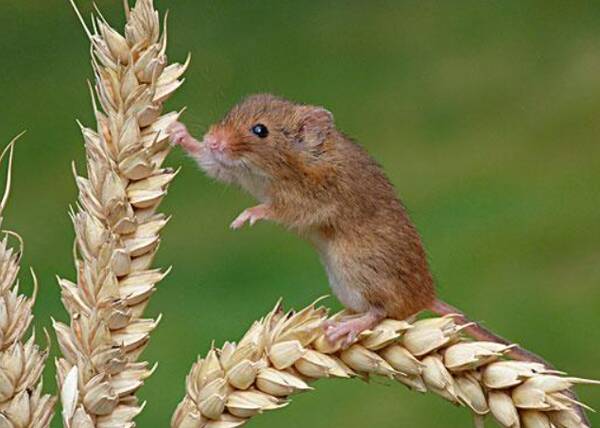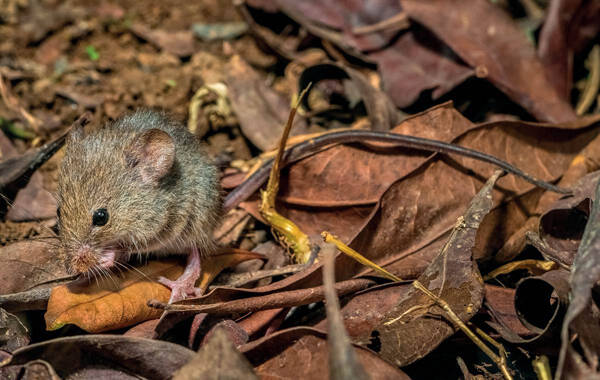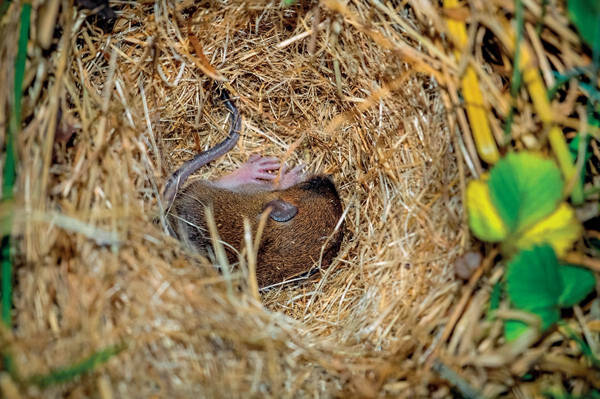Micromys minutus
IUCN
LCBasic Information
Scientific classification
- name:Micromys minutus
- Scientific Name:Micromys minutus,Oat rats, garden rats, dwarf rats, etc.
- Outline:Rodents
- Family:Rodentia Muridae Genus
Vital signs
- length:5-8cm
- Weight:8-11g
- lifetime:
Feature
They get their name from the fact that they build their nests on plant stems. Apart from the northern jerboa of the family Jerboa, they are the smallest representatives of the order Rodentia.
Distribution and Habitat
In China, it is distributed throughout the country except for deserts, wastelands and high-altitude areas in Tibet. Abroad, it is distributed in Europe and northern Asia.
The nest mouse lives in relatively humid areas in plains below 1,000 meters above sea level. Its typical habitats are reed fields, sandy land, and pastoral oases.
Appearance
The body is small, with body length less than 70mm and hind foot length less than 16mm. Tail length is usually slightly longer than body length. The hair on the back of the body is reddish brown, and the belly is grayish white. The remarkable feature is that the tail is very flexible and can be wrapped around. When the nest rat climbs onto plants such as wheat, the tail can be wrapped around the plant, freeing its forelimbs and upper body to feed on wheat grains for a long time, and among different plants. move between. Another characteristic is hairy ears. The shape of the teeth is similar to that of the squirrel. The 1st and 2nd upper molars are composed of three longitudinal rows. Each tooth has 3 odontoid processes on the lingual side, but they are much smaller in size. The total skull length is only about 15mm.
Details
The nest mouse belongs to the Murinae subfamily. There are only two species in the world, and both are distributed in my country. The taxonomic status of the nest mouse is stable, but there are many subspecies, which is somewhat controversial. It is a common species in wheat fields, rice fields, tall grass grasslands and shrub ecosystems. It builds nests and reproduces in the middle and upper parts of rice, wheat and tall grass. The nest is spherical, with a very small opening and a diameter of 5-10mm.

The nest mouse is often active at night, and sometimes active during the day and night. During the day, it is common to see young mice in the nest, while the mother mouse is out of the hole. It is small and flexible, likes to climb, and often uses its tail to assist its limbs to climb on crop ears or branches to find food. It can occasionally swim in shallow water.
Nest mice are omnivorous animals. They like to eat corn, millet, soybeans, rice and other grains, and also eat berries, tea seeds, etc. Before the crops mature, they mainly eat the green parts of plants.
Nest mice can build nests with plant stems and leaves on the stems and branches of plants in weeds and shrubs. The nest is generally 30 to 100 cm from the ground. The nest is spherical or oval, and generally has only one nest opening.
In summer, the nest mice put many grass stems together on the stems of weeds and crops, and use plant leaves to build a spherical nest, which is about the size of a fist and has only one nest opening. In autumn, they often make a disc-shaped nest in the haystack or dig a hole in the ground. In winter, the nest mice build a nest in the haystack, or dig a hole in the ground and build a ground nest with grass balls. In spring, the nest mice will abandon it and build a new nest.

Nest mice like to live near bushes and weeds around ponds and lakes. They can live in shrubs at the edge of forests and crop fields in grassland areas. In autumn, nest mice gather under the grain bundles in the fields and in the grain stacks in the threshing yard.
The breeding season of nest mice is from March to October every year, and the gestation period is 18 to 21 days. One to four litters can be produced every year, with 5 to 8 pups per litter. The pups open their eyes 8 to 9 days after birth, and can move independently after 15 days. In Northeast China, nest mice have 6 to 9 pups per litter. Nest mice breed in the Soviet Union from March to October, with a gestation period of 18 to 20 days, and 1 to 4 litters per year, with 5 to 8 pups per litter.
The peak of the nest mouse population is basically the same as the maturity of crops. The season with the least number is March, and the season with the most number is October to November (the end of the breeding period). In suitable living areas, the annual change of the number of nest mice is not large - there is no situation where it increases by 2 to 2.5 times.

Nest rats are harmful to both agriculture and animal husbandry, and are one of the main pests in the plains and low mountain pastures in northern Inner Mongolia. In agricultural areas, the growth of crops can cause large areas of wheat fields to lack seedlings and break ridges, resulting in no harvest. In nature, they can be infected with diseases such as plague and tularemia.
This species is listed in the 2013 IUCN Red List of Threatened Species Ver3.1—Vulnerable (VU).
It has been included in the "National List of Terrestrial Wildlife with Important Economic and Scientific Research Value" issued by the State Forestry Administration of China on August 1, 2000.








